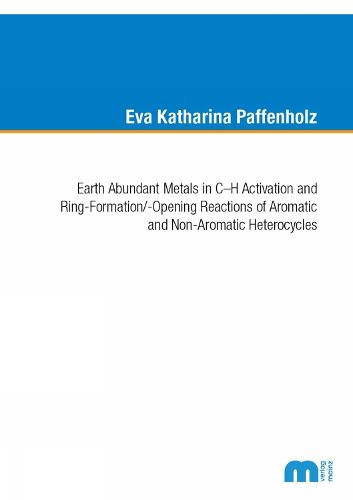Readings Newsletter
Become a Readings Member to make your shopping experience even easier.
Sign in or sign up for free!
You’re not far away from qualifying for FREE standard shipping within Australia
You’ve qualified for FREE standard shipping within Australia
The cart is loading…






In the last decades, C-H activation became an increasingly powerful tool for C-C bond formation. It provided a valid alternative to conventional cross coupling reactions with maximised atom- and step-economy for synthetic reactions. Even though a lot of great advances have been made, some challenges in C-H activations remain. C-H bonds are highly stable (110 kcal/mol), often harsh reaction conditions are needed to break the bond and form a new C-C compound. Furthermore, regioselectivity has been proven to be a difficult issue since a number of C-H bonds are present in organic molecules. Also, chemoselectivity still remains a difficulty to overcome in C-H activation reactions. Many groups focus their research on developing mild reaction conditions that proceed at "ambient temperature, neutral conditions and in absence of strong oxidants or reductants".[1b] By choosing milder reaction conditions also problems of selectivity can be managed. In general, the catalytic cycle of C-H activation reactions follows four reaction steps: first is the C-H activation itself, where a substrate binds to the metal that catalyses the reaction process (I). Next is the functionalisation of the organometal intermediate with an appropriate reaction partner (II). By releasing the product (III) and regeneration of the catalyst, e.g. with an oxidant (IV), the catalytic cycle is closed.
$9.00 standard shipping within Australia
FREE standard shipping within Australia for orders over $100.00
Express & International shipping calculated at checkout
In the last decades, C-H activation became an increasingly powerful tool for C-C bond formation. It provided a valid alternative to conventional cross coupling reactions with maximised atom- and step-economy for synthetic reactions. Even though a lot of great advances have been made, some challenges in C-H activations remain. C-H bonds are highly stable (110 kcal/mol), often harsh reaction conditions are needed to break the bond and form a new C-C compound. Furthermore, regioselectivity has been proven to be a difficult issue since a number of C-H bonds are present in organic molecules. Also, chemoselectivity still remains a difficulty to overcome in C-H activation reactions. Many groups focus their research on developing mild reaction conditions that proceed at "ambient temperature, neutral conditions and in absence of strong oxidants or reductants".[1b] By choosing milder reaction conditions also problems of selectivity can be managed. In general, the catalytic cycle of C-H activation reactions follows four reaction steps: first is the C-H activation itself, where a substrate binds to the metal that catalyses the reaction process (I). Next is the functionalisation of the organometal intermediate with an appropriate reaction partner (II). By releasing the product (III) and regeneration of the catalyst, e.g. with an oxidant (IV), the catalytic cycle is closed.